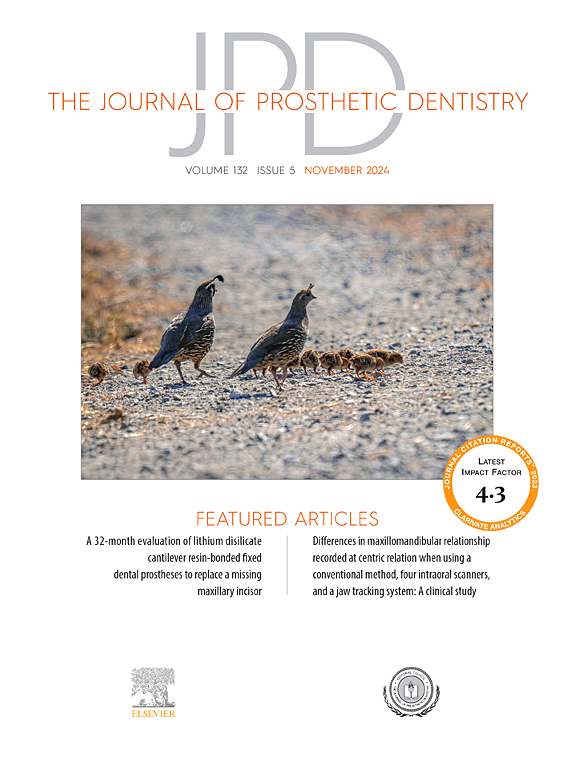在聚甲基丙烯酸甲酯中添加石墨烯纤维对生物相容性和表面特性的影响。
IF 4.3
2区 医学
Q1 DENTISTRY, ORAL SURGERY & MEDICINE
引用次数: 0
摘要
问题简介:临时固定义齿用于在安装最终义齿之前提供美观和维持功能。聚甲基丙烯酸甲酯(PMMA)已被广泛用作临时材料,但其机械性能有限,添加石墨烯纤维(PMMA-G)等纳米材料后可改善机械性能。目的:本体外研究的目的是通过洗脱法测量不同浓度两种化合物作用下牙周韧带干细胞(PDLSCs)的存活率和细胞凋亡情况,以及这些材料的表面特征,从而确定 PMMA 与 PMMA-G 对牙周韧带干细胞(PDLSCs)的生物相容性和细胞毒性作用:无菌的 Ø20×15 mm PMMA 和 PMMA-G 试样用 Dulbecco 改良鹰培养基覆盖 24 小时,作为后续洗脱液。将 PDLSCs 按每种材料 1/1、1/2、1/4 和 1/8 的稀释度种于 6 个 96 孔板中。在 24、48 和 72 小时内,依次用 3 个平板进行 MTT 细胞活力检测,用 3 个平板进行 Hoechst 33342 染色细胞凋亡检测。使用 Kruskal-Wallis 检验比较不同稀释液在不同时间获得的数据,使用 Mann-Whitney 检验比较两种材料。对地形和润湿进行了分析,以确定表面特征。采用配对测量的学生 t 检验来比较不同表面的各项参数(所有检验均采用 α=.05):在细胞存活率检测(MTT)和细胞凋亡检测中,均未发现 PMMA 和 PMMA-G 与对照组在不同稀释度、不同时间的差异有统计学意义(P>.05)。在比较两种材料时,均未发现有统计学意义的差异(P=.268)。与 PMMA 相比,PMMA-G 的粗糙度和峰度较低,湿润度较高:结论:PMMA 和 PMMA-G 都是生物相容性材料,在细胞存活率和细胞凋亡测试后,两者之间没有明显差异。与 PMMA 相比,PMMA-G 具有更高的润湿性和更低的粗糙度。本文章由计算机程序翻译,如有差异,请以英文原文为准。
Effects of adding graphene fibers to polymethyl methacrylate on biocompatibility and surface characterization
Statement of problem
Interim fixed prostheses are used provisionally to provide esthetics and maintain function until placement of the definitive prosthesis. Polymethyl methacrylate (PMMA) has been widely used as an interim material but has mechanical limitations that can be improved with the addition of nanomaterials such as graphene fibers (PMMA-G). However, studies on the biocompatibility of this material are lacking.
Purpose
The purpose of this in vitro study was to determine the biocompatibility and cytotoxic effects of PMMA compared with PMMA-G in periodontal ligament stem cells (PDLSCs) by measuring the viability and cell apoptosis of those cells subjected to different concentrations of both compounds by elution, as well as the surface characterization of these materials.
Material and methods
Sterile Ø20×15-mm specimens of PMMA and PMMA-G were covered with Dulbecco modified Eagle medium for 24 hours to be the subsequent eluent. PDLSCs were seeded in 6 plates of 96 wells at dilutions 1/1, 1/2, 1/4, and 1/8 for each material. Three plates for the cell viability assay with MTT and 3 plates for the cell apoptosis assay with Hoechst 33342 staining were used in turn to subdivide the measurements at 24, 48, and 72 hours. The Kruskal-Wallis test was used to compare the data obtained in the different dilutions at different times and the Mann-Whitney test to compare both materials. Topography and wetting were analyzed for surface characterization. The Student t test of paired measurements was used to compare the different surfaces for each parameter (α=.05 for all tests).
Results
In both the cell viability assay (MTT) and the cell apoptosis assay, the test did not identify statistically significant differences in PMMA and PMMA-G with respect to the control group in the different dilutions at different times (P>.05). When comparing both materials, no statistically significant differences (P=.268) were found in either trial. PMMA-G had lower roughness and kurtosis and higher wetting than PMMA.
Conclusions
Both PMMA and PMMA-G were found to be biocompatible materials with no significant differences between them after cell viability and apoptosis testing. PMMA-G had higher wettability and lower roughness than PMMA.
求助全文
通过发布文献求助,成功后即可免费获取论文全文。
去求助
来源期刊

Journal of Prosthetic Dentistry
医学-牙科与口腔外科
CiteScore
7.00
自引率
13.00%
发文量
599
审稿时长
69 days
期刊介绍:
The Journal of Prosthetic Dentistry is the leading professional journal devoted exclusively to prosthetic and restorative dentistry. The Journal is the official publication for 24 leading U.S. international prosthodontic organizations. The monthly publication features timely, original peer-reviewed articles on the newest techniques, dental materials, and research findings. The Journal serves prosthodontists and dentists in advanced practice, and features color photos that illustrate many step-by-step procedures. The Journal of Prosthetic Dentistry is included in Index Medicus and CINAHL.
 求助内容:
求助内容: 应助结果提醒方式:
应助结果提醒方式:


